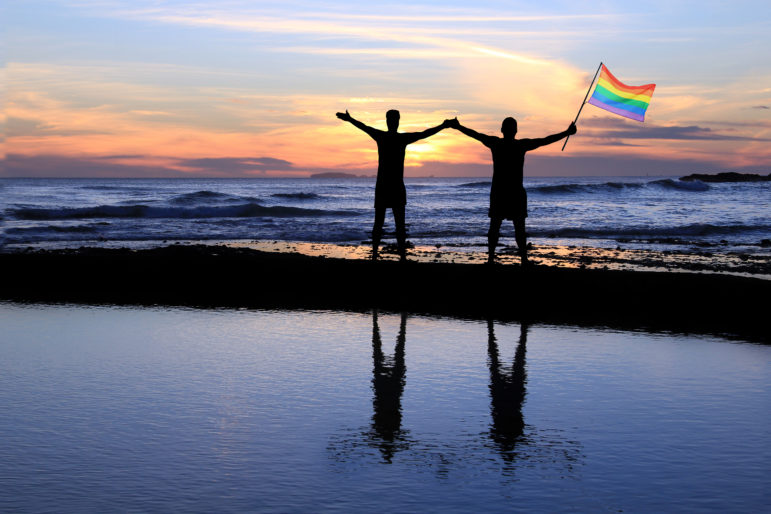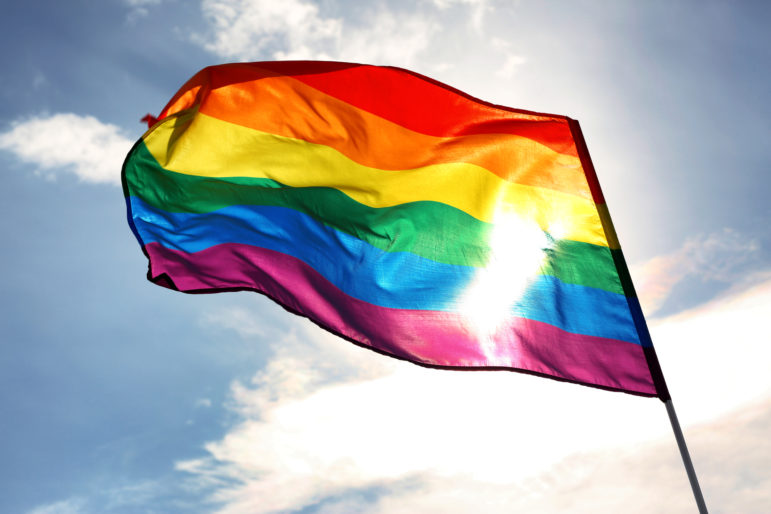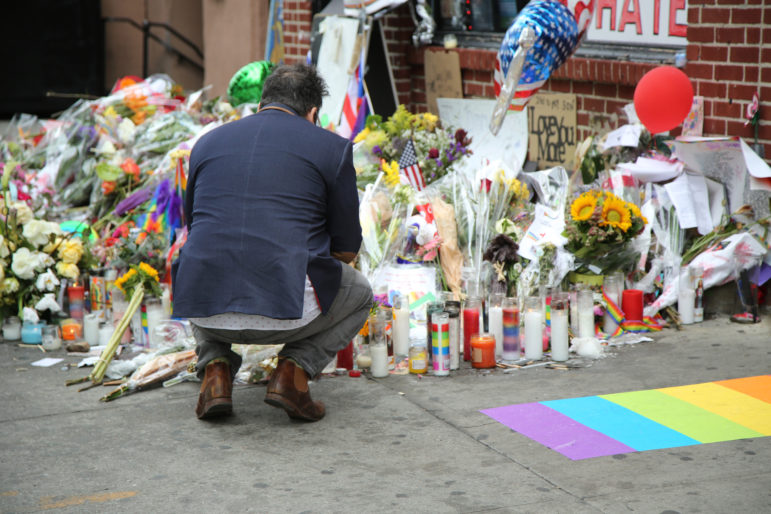
Most of this year’s Pride Month is taking place during a Mercury Retrograde. But don’t worry! It’s not as bad as the “occult press” might have you believe. True, this is often a time in which we experience miscommunications, technological glitches, and so on, but it is also a time to review the past so that when Mercury goes direct (on June 22, just in time for Pride Day – yay!) we will be in a better position to implement changes in our approach to maximize our chances at achieving our goals.
Goals? For a party? The first thing to remember is that Pride is not “just a party.” It is a celebration, yes, but one that was born out of a history of violent oppression. And that violence is far from over. Despite the gains that we have made over the past several years, hate crimes are on the rise in the United States and we still do not have federal protections in the areas of jobs, housing, and services. Religious exemptions are even threatening to allow medical workers to refuse administering medical care to queer people if to do so would violate the practitioners’ religious beliefs. This is far more important than wedding cakes, but we see now where these exemptions lead.
Since this is a time for reflection and contemplation, I’d like to take a look back on how we have experienced Pride over the past several years, as well as some of the influential events in LGBTQ+ history, to get a better sense of where we are currently, how far we have come, and perhaps even how much farther we still really need to go.

Two silhouetted figures standing on a beach holding a Pride flag [DepositPhotos]
For those new to the queer scene, June has been designated “Pride Month” because of the 1969 Stonewall Riots that took place June 28 of that year. At that time homosexuality was illegal via anti-sodomy laws in most of the states, and we often saw police harassing and abusing queer people and establishments. The Stonewall Inn was not the first queer uprising against a homophobic police force, but the four day uprising proved to be an important catalyst which galvanized the queer rights movement on an international level. This year marks the 52nd anniversary of that event and we have made many strides (and shed many tears) since that fateful time.
The year after those riots, the first “Gay Liberation Pride March” was held in New York City, beginning a trend toward visibility that would eventually assist us in gaining political and social ground.
In 1978, the first rainbow flag was flown at the San Francisco at the “Gay Freedom Parade.” The flag (in its now various forms) has become an international symbol of queer freedom and pride. Later that year, also in San Francisco, San Francisco Supervisor Harvey Milk was assassinated, along with Mayor George Moscone. Supervisor Dan White was convicted of voluntary manslaughter and was sentenced to just seven years in prison, largely due to what has been called “the Twinkie Defense.” He served five years and was released early. Two years after his release White took his own life.

A Pride flag [DepositPhotos]
In 1979, the National March on Washington for Lesbian and Gay Rights saw over 100,000 people gather in support of queer rights. Things seemed to be getting better and better for the queer community, but hope and happiness was seemingly shattered in June of 1981 when the first cases appeared of what was then called GRID (Gay Related Immunodeficiency Disorder – later renamed AIDS). In the U.S. alone, a total of 583,298 people would die from the disease through 2007. Nearly an entire generation of gay and bisexual men were wiped off the face of the earth in what many had called “the gay plague”.
In 1986, the Supreme Court decision Bowers v. Hardwick asserted in a 5-4 vote that consensual oral and anal sex between adults was illegal and that there would be no constitutional protections.
In June of 2003 the above ruling was overturned by the Supreme Court, causing the last of the anti-sodomy laws in the United States to be finally struck down on the federal level, invalidating the remaining anti-sodomy laws on the books in 14 states.
In June of 2009, President Obama signed a Presidential Memorandum which allowed the same-sex partners of federal employees to receive (some) benefits. Full health care was conspicuously absent from this directive.
In 2011 Obama announced that his administration would no longer defend the Defense of Marriage Act, which had banned the recognition of same-sex marriage on the federal level. In June of that same year, New York passed the Marriage Equity Act and became the largest state to legalize same-sex marriages.
In June of 2015, another milestone for the queer community came in the form of Obergefell v. Hodges, which the Supreme Court decided in a 5-4 vote. This ruling struck down the discriminatory laws that prevented same-sex couples from getting legally married and opened the door in all fifty states for gay marriages to be enacted.
The new millennium hasn’t all been easy. On June 12, 2016, a gunman walked into the Pulse nightclub in Orlando, Florida, and opened fire killing 49 people. The U.N. Security Council, in its very first statement on sexual orientation, condemned the massacre as a terrorist act.

NEW YORK – JUNE 16, 2016: Mourner honors Orlando massacre victims at the gay rights landmark Stonewall Inn in New York City [Zhukovsky, DepositPhotos]
During his single term, President Trump did much to erode protections for the queer community, even as he claimed to do otherwise. While he did appoint several openly gay men to high-ranking diplomatic and national security positions, this was later seen to be a smokescreen, as he initiated a ban on trans people serving in the military and repealed healthcare guarantees for trans patients. He also threatened queer and women’s rights under the pretense of religious liberty. As an added insult, in his final days in office he directed the Department of Human Health and Services to discriminate against queer people in areas such as adoption, refugee assistance, and HIV prevention. Thankfully the Biden Administration has since worked to restore protections and expand them.
Globally we have seen some strides in recent years. In 2017 Ireland elected its first openly gay Prime Minister, and other countries such as Japan and Serbia have seen gay members of government being elected.
While some falsely believe that equality has been achieved, even closer to home, in the United States, there is still work to be done. While some states offer protections based on sexual orientation, there are still no federal laws to protect certain rights of queer citizens, such as regarding employment, housing, and public services.
There is progress being made, even if there is still much more that needs to be done. Homosexuality is still illegal in 69 UN member states, and some, including Iran, Afghanistan, Nigeria, and Malaysia carry the death penalty for a conviction. It is because of these state sponsors of homophobia that organizations such as the Rainbow Railroad work tirelessly to protect queer people from their oppressive governments.
It is important that we remember the struggles of queer people, both historic and current, as we prepare to celebrate how far we have come. Pride is many things to many people: a party, a celebration, a commercial money grab, a remembrance, a memorial. It is all things, rolled up into one messy, colorful, outrageous, experience. (And in 2020, that experience was virtual, due to the global pandemic.)
This year is looks like many Pride celebrations will be returning, if in somewhat limited forms. “The Fight Continues,” says the motto for the New York celebration this year.
I make it a point to consider the obstacles that my queer ancestors faced that I have not had to face myself. I know that the rights that I enjoy today were won with the sweat, tears, and even blood of many, many queer people. Pride celebrations are a way to remember that past, to honor it, but also to help transform the pain of our collective past into a viable and hopeful future. This is a true act of magic and one in which we can all participate by lifting the voices of queer people and refusing to allow those voices to be silenced. This is the power behind the chant, “I’m here! I’m queer! Get used to it!” We have always been here. And we are here to stay. We have overcome so much adversity in our collective history and yet we just keep coming back. And we look fabulous doing it.
Happy Pride!
The Wild Hunt always welcomes guest submissions. Please send pitches to eric@wildhunt.org.
The views and opinions expressed by our diverse panel of columnists and guest writers represent the many diverging perspectives held within the global Pagan, Heathen and polytheist communities, but do not necessarily reflect the views of The Wild Hunt Inc. or its management.
The Wild Hunt is not responsible for links to external content.
To join a conversation on this post:
Visit our The Wild Hunt subreddit! Point your favorite browser to https://www.reddit.com/r/The_Wild_Hunt_News/, then click “JOIN”. Make sure to click the bell, too, to be notified of new articles posted to our subreddit.